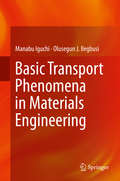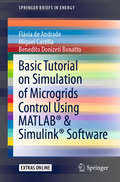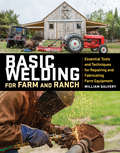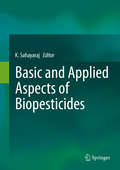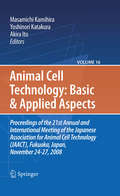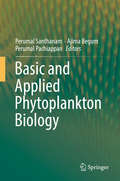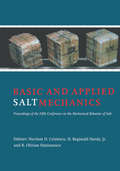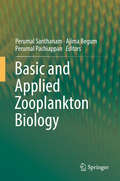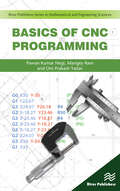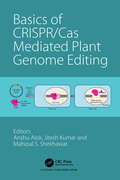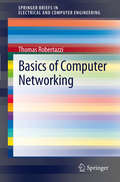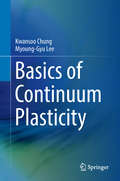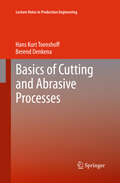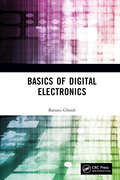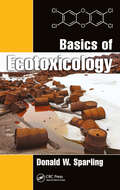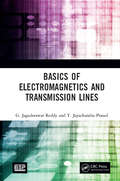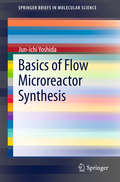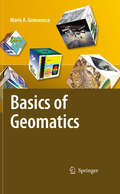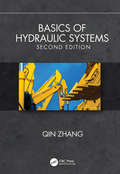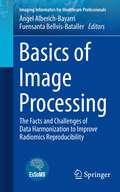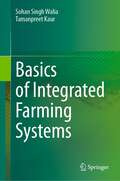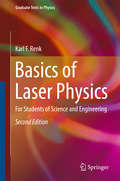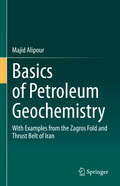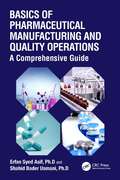- Table View
- List View
Basic Transport Phenomena in Materials Engineering
by Manabu Iguchi Olusegun J. IlegbusiThis book presents the basic theory and experimental techniques of transport phenomena in materials processing operations. Such fundamental knowledge is highly useful for researchers and engineers in the field to improve the efficiency of conventional processes or develop novel technology. Divided into four parts, the book comprises 11 chapters describing the principles of momentum transfer, heat transfer, and mass transfer in single phase and multiphase systems. Each chapter includes examples with solutions and exercises to facilitate students' learning. Diagnostic problems are also provided at the end of each part to assess students' comprehension of the material. The book is aimed primarily at students in materials science and engineering. However, it can also serve as a useful reference text in chemical engineering as well as an introductory transport phenomena text in mechanical engineering. In addition, researchers and engineers engaged in materials processing operations will find the material useful for the design of experiments and mathematical models in transport phenomena. This volume contains unique features not usually found in traditional transport phenomena texts. It integrates experimental techniques and theory, both of which are required to adequately solve the inherently complex problems in materials processing operations. It takes a holistic approach by considering both single and multiphase systems, augmented with specific practical examples. There is a discussion of flow and heat transfer in microscale systems, which is relevant to the design of modern processes such as fuel cells and compact heat exchangers. Also described are auxiliary relationships including turbulence modeling, interfacial phenomena, rheology, and particulate systems, which are critical to many materials processing operations.
Basic Tutorial on Simulation of Microgrids Control Using MATLAB® & Simulink® Software (SpringerBriefs in Energy)
by Miguel Castilla Benedito Donizeti Bonatto Flávia de AndradeThis book offers a detailed guide to the design and simulation of basic control methods applied to microgrids in various operating modes, using MATLAB® Simulink® software. It includes discussions on the performance of each configuration, as well as the advantages and limitations of the droop control method. The content is organised didactically, with a level of mathematical and scientific rigour suitable for undergraduate and graduate programmes, as well as for industry professionals. The use of MATLAB® Simulink® software facilitates the learning process with regard to modelling and simulating power electronic converters at the interface of distributed energy resource (DER) systems. The book also features a wealth of illustrations, schematics, and simulation results. Given its scope, it will greatly benefit undergraduate and graduate students in the fields of electrical and electronics engineering, as well as professionals working in microgrid design and implementation.
Basic Welding for Farm and Ranch: Essential Tools and Techniques for Repairing and Fabricating Farm Equipment
by William GalveryFarmers, ranchers, and homesteaders who know how to weld can repair and even fabricate some equipment on their own, saving both time and money. Basic Welding for Farm and Ranch introduces this crucial skill and covers the most popular techniques used by the home hobbyist and DIY devotee, with chapters and detailed illustrations dedicated to oxyacetylene welding (or gas welding), stick welding, MIG, and arc welding, as well as brazing and soldering. Along with guidance on equipment selection and use, and safety precautions, this book offers 12 projects and repairs commonly faced on the small farm or homestead, with step-by-step photography guiding readers through building a wall-mount hay feeder, repairing a garden rake, making horseshoe hooks, and more. This publication conforms to the EPUB Accessibility specification at WCAG 2.0 Level AA.
Basic and Applied Aspects of Biopesticides
by K. SahayarajCurrently, the major challenge of humanity is focused on population growth through agricultural production in order to meet the demand for food. The food crunch is mainly due to pest and disease. Traditional methods, synthetic insecticides and microbicides cause health hazards to human beings, domestic animals and also affect our immediate environments. Serious concerns were implemented by both developing and developed countries as Integrated Pest Management (IPM) and Bio-intensive Integrated Pest Management (BIPM) systems where biopesticides play an important role worldwide. The available books are limited to particular aspects of biopesticides. Hence, it is imperative to bring out a holistic documentation which will provide the reader information on all aspects of biopesticides. The book consists of five sections namely microbials, botanicals, natural enemies semio- chemicals and biotechnology and equipments, bioinformatics tools and IPM. In Section I, microbial deals with utilization of Bacillus in control of phytonematodes; biological control of pest and diseases with fluorescent pseudomonads, entomopathogenic fungus and entomopathogenic nematodes in pest management, microbial viral insecticides and microbial elicitors to induce immunity for plant disease control in chilli and tomato. Importance of plant essential oils, botanicals in endocrine disruption, relevance of botanicals and use of plant volatile on pest management has been discussed in Section II. Importance and role of reduviidae, weaver ants, ground beetles, Odonatas, spiders in biological control has been discussed in Section III. In addition, genetic improvement of biocontrol agents for sustainable pest management has also been highlighted. In Section IV, classical practices and pheromone, kairomonal enhancement to natural enemies and use of transgenic plants in insect control are highlighted. Equipment and their application methodologies for application of biopesticides; relevance of bioinformatics in biopesticides management; pest management of soybean, bio fouling and eco friendly antifoulants have been highlighted in Section V. Each chapter has objectives and conclusion along with recommendations.
Basic and Applied Aspects: Proceedings of the 21st Annual and International Meeting of the Japanese Association for Animal Cell Technology (JAACT), Fukuoka, Japan, November 24-27, 2008 (Animal Cell Technology: Basic & Applied Aspects #16)
by Masamichi Kamihira Akira Ito Yoshinori KatakuraAnimal cell technology is a growing discipline of cell biology which aims not only to understand the structure, function and behavior of differentiated animal cells, but also to ascertain their ability to be used for industrial and medical purposes. Some of the major goals of animal cell technology include: the clonal expansion of differentiated cells, the optimization of their culture conditions, modulation of their ability for the production of medically and pharmaceutically important proteins and the application of animal cells to gene therapy, artificial organs and functional foods. This volume gives the readers a complete review of the present state-of-the-art research in Japan and other countries where this field is well advanced. The Proceedings will be useful to cell biologists, biochemists, molecular biologists, immunologists, biochemical engineers and to those working in either academic environments or in the biotechnology and pharmacy industries related to animal cell culture.
Basic and Applied Phytoplankton Biology
by Perumal Pachiappan Perumal Santhanam Ajima BegumThis book presents the latest developments and recent research trends in the field of plankton, highlighting the potential ecological and biotechnological applications. It critically and comprehensively discusses strain selection, growth characteristics, large-scale culturing, and biomass harvesting, focusing on the screening and production of high-value products from algae, and evaluating carbon dioxide sequestration from fuel gas as a climate change mitigation strategy. The latter areas of research are clearly central to the sustainable development approach that is currently attracting global attention.Over the decades, much of the literature on has focused on the biological and ecological aspects of phytoplankton found in freshwater, marine and brackish water environments. However, these organisms are known to also inhabit various other environments. More recently, there has been a substantial shift toward the concept of sustainable development and the “green economy” with emphasis on exploiting biological systems for the benefit of mankind. The significance of these plankton cannot be underestimated as they contribute approximately 40% of the oxygen in the atmosphere. Therefore, there is potential for exploitation of this invaluable biomass source that could lead to significant environmental and economic benefits for man.Providing a comprehensive outline of the most recent developments and advances in the field of industrial applications of these plankton, this book is an excellent reference resource for researchers and practitioners.
Basic and Applied Salt Mechanics: Proceedings of the 5th Conference on Mechanical Behaviour of Salt, Bucharest, 9-11 August 1999
by N. D. CristescuPapers cover: laboratory and in-situ testing; coupled effects and permeability; creep damage and dilatancy; constitutive modelling; crushed salt behaviour; numerical modelling; storage and disposal projects; mining applications; case studies; and salt pillars and cavities.
Basic and Applied Zooplankton Biology
by Perumal Pachiappan Perumal Santhanam Ajima BegumThe coastal and ocean ecosystem is a significant feature of our planet and provides a source of food for much of life on Earth. Millions of species have been, and are still being discovered in the world’s oceans. Among these zooplankton serve as secondary producers and are significant as they form pelagic food links and act as indicators of water masses. They constitute the largest and most reliable source of protein for most of the ocean’s fishes. As such, their absence or depletion often affects fishery. In many countries, the decline in fishery has been attributed to reduced plankton populations. Furthermore, trillions of tiny copepods produce countless faecal pellets contributing greatly to the marine snow and therefore accelerating the flow of nutrients and minerals from the surface waters to the seabed. They are phylogenetically highly successful groups in terms of phylogenetic age, number of living species and success of adaptive radiation. A study of the basic and applied aspects of zooplankton would provide an index of the fishery potential and applications, offering insights into ocean ecology to safeguard food supplies and livelihoods of the millions of people living in coastal areas. For this reason, we need to understand all the facets of zooplankton as well as their interactions with atmosphere and other life forms, including human. In this context, this book discusses the basic and applied aspects of zooplankton, especially taxonomy, mosquitocidal activity, culture, analysis of nutritional, pigments and enzyme profile, preservation of copepods eggs, bioenrichment of zooplankton and application of zooplankton in sustainable aquaculture production, focusing on novel biofloc-copefloc technologies, and the impact of acidification and microplastics on zooplankton.Offering a comprehensive overview of the current issues and developments in the field of environmental and commercial applications, this book is a valuable resource for researchers, aquaculturists, environmental mangers wanting to understand the importance of zooplankton and develop technologies for the sustainable production of fish and other commodities to provide food and livelihoods for mankind.
Basics of CNC Programming
by Mangey Ram Om Prakash Yadav Pawan NegiBefore the introduction of automatic machines and automation, industrial manufacturing of machines and their parts for the key industries were made though manually operated machines. Due to this, manufacturers could not make complex profiles or shapes with high accuracy. As a result, the production rate tended to be slow, production costs were very high, rejection rates were high and manufacturers often could not complete tasks on time.Industry was boosted by the introduction of the semi-automatic manufacturing machine, known as the NC machine, which was introduced in the 1950’s at the Massachusetts Institute of Technology in the USA. After these NC machine started to be used, typical profiles and complex shapes could get produced more readily, which in turn lead to an improved production rate with higher accuracy.Thereafter, in the 1970’s, an even larger revolutionary change was introduced to manufacturing, namely the use of the CNC machine (Computer Numerical Control). Since then, CNC has become the dominant production method in most manufacturing industries, including automotive, aviation, defence, oil and gas, medical, electronics industry, and the optical industry. Basics of CNC Programming describes how to design CNC programs, and what cutting parameters are required to make a good manufacturing program. The authors explain about cutting parameters in CNC machines, such as cutting feed, depth of cut, rpm, cutting speed etc., and they also explain the G codes and M codes which are common to CNC. The skill-set of CNC program writing is covered, as well as how to cut material during different operations like straight turning, step turning, taper turning, drilling, chamfering, radius profile, profile turning etc. In so doing, the authors cover the level of CNC programming from basic to industrial format. Drawings and CNC programs to practice on are also included for the reader.
Basics of CRISPR/Cas Mediated Plant Genome Editing
by Anshu Alok Jitesh Kumar Mahipal S. ShekhawatCRISPR/Cas has emerged, as a powerful genetic engineering tool. It is simple yet highly affordable and robust. This book provides a basic introduction to the mechanism and architecture of the CRISPR/Cas. It enlightens the readers about the new advancements such as gene insertion, transcriptional activation, suppression, gene tagging, multiplexing, base editing, prime editing, and tissue culture free editing which makes it easier for crop improvement. With such technologies, application of genome editing has opened new paths for crop improvements and sustainable agriculture. The current book will be useful for beginners to understand these tools and how to use them in a better and more efficient way.
Basics of Computer Hardware (OE-101-ELS) First Semester FYBA, B.COM New NEP Syllabus - SPPU
by Prof. Dr. P. B. Buchade Prof. Dr. M. L. Dongare S. R. Chaudhari Ms Shital KanasakarA textbook on Basics of Computer Hardware designed for undergraduate students as per the National Education Policy (NEP) syllabus. It offers an introduction to computer fundamentals, including computer components, microprocessors, memory, and peripherals. Topics range from defining and classifying computers to explaining microprocessors' working, motherboard architecture, and input/output devices. With diagrams, examples, and exercises, the book simplifies complex concepts for beginners, preparing them for careers in electronics and related fields.
Basics of Computer Networking (SpringerBriefs in Electrical and Computer Engineering)
by Thomas RobertazziSpringer Brief Basics of Computer Networking provides a non-mathematical introduction to the world of networks. This book covers both technology for wired and wireless networks. Coverage includes transmission media, local area networks, wide area networks, and network security. Written in a very accessible style for the interested layman by the author of a widely used textbook with many years of experience explaining concepts to the beginner.
Basics of Continuum Plasticity
by Kwansoo Chung Myoung-Gyu LeeThis book describes the basic principles of plasticity for students and engineers who wish to perform plasticity analyses in their professional lives, and provides an introduction to the application of plasticity theories and basic continuum mechanics in metal forming processes. This book consists of three parts. The first part deals with the characteristics of plasticity and instability under simple tension or compression and plasticity in beam bending and torsion. The second part is designed to provide the basic principles of continuum mechanics, and the last part presents an extension of one-dimensional plasticity to general three-dimensional laws based on the fundamentals of continuum mechanics. Though most parts of the book are written in the context of general plasticity, the last two chapters are specifically devoted to sheet metal forming applications. The homework problems included are designed to reinforce understanding of the concepts involved. This book may be used as a textbook for a one semester course lasting fourteen weeks or longer. This book is intended to be self-sufficient such that readers can study it independently without taking another formal course. However, there are some prerequisites before starting this book, which include a course on engineering mathematics and an introductory course on solid mechanics.
Basics of Cutting and Abrasive Processes (Lecture Notes in Production Engineering)
by Berend Denkena Hans Kurt ToenshoffManufacturing is the basic industrial activity generating real value. Cutting and abrasive technologies are the backbone of precision production in machine, automotive and aircraft building as well as of production of consumer goods. We present the knowledge of modern manufacturing in these technologies on the basis of scientific research. The theory of cutting and abrasive processes and the knowledge about their application in industrial practice are a prerequisite for the studies of manufacturing science and an important part of the curriculum of the master study in German mechanical engineering. The basis of this book is our lecture "Basics of cutting and abrasive processes" (4 semester hours/3 credit hours) at the Leibniz University Hannover, which we offer to the diploma and master students specializing in manufacturing science.
Basics of Digital Electronics
by Banani GhoshThis book contains short definitions and descriptions followed by examination material for Digital Electronics. The topics included are: Analog and Digital Signals Number Systems Combinational Logic Circuits Multiplexer, Demultiplexer, Encoder, Decoder Binary Arithmetic Digital Logic Families Different Types of Displays Print edition not for sale in South Asia (India, Sri Lanka, Nepal, Bangladesh, Pakistan or Bhutan)
Basics of Ecotoxicology
by Donald W. SparlingThe material presented in this textbook will not require the need for prior knowledge of chemistry, biology, or statistics to be understood, rather, it will provide sufficient related background information leading to a competency to clearly understand ecotoxicology concepts and topics.
Basics of Electromagnetics and Transmission Lines
by G. Jagadeeswar Reddy T. Jayachandra PrasadThis book provides a complete awareness on the subject EMTL with regards to both theoretical and practical aspects of the subject. Various concepts from fundamentals to advanced topics are presented and discussed adequately. The book’s bottom-up approach ensures that students understand all the basic building blocks before the development of a real-life system. Numerical problems and day-to-day examples, practical situations that occur in industries & daily life are also presented. Please note: Taylor & Francis does not sell or distribute the Hardback in India, Pakistan, Nepal, Bhutan, Bangladesh and Sri Lanka.
Basics of Flow Microreactor Synthesis (SpringerBriefs in Molecular Science)
by Jun-Ichi YoshidaThis book provides in a concise form the principles and applications of flow microreactors in organic and polymer synthesis. Recently, it became possible to conduct chemical reactions in a flow reactor in laboratory synthesis. The flow microreactor enables reactions that cannot be done in batch, opening a new possibility of chemical synthesis. Extremely fast mass and heat transfer and high-resolution residence time control are responsible for the remarkable features of that process. The book is not an exhaustive compilation of all known examples of flow microreactor synthesis. Rather, it is a sampling of sufficient variety to illustrate the concept, the scope, and the current state of flow microreactor synthesis. Researchers both in academia and in industry will be interested in this book because the topics encompassed by the book are vigorously studied in many university and company laboratories today.
Basics of Geomatics
by Mario A. GomarascaThis volume presents a comprehensive and complete treatment. In a systematic way the complex topics and techniques are covered that can be assembled under Geospatial Information namely, Geodesy, Cartography, Photogrammetry, Remote Sensing, Informatics, Acquisition Systems, Global Positioning Systems, Digital Image Processing, Geographic Information Systems, Decision Support Systems, and WebGIS. It describes in detail and at an accessible level - too much math has been avoided - the state of current knowledge. Per chapter a detailed bibliography has been included. As such, it will serve as a working tool not only to geoscientists and geographers but also to engineers, architects, computer scientists, urban planners, specialists in GIS, remote sensing, forestry, agricultural science, soil science geometry, environmental scientists and managers. Applications can be found in security, risk management, monitoring, info-mobility, geo-positioning, food traceability, etc. From the reviews: "The book is rigorous and synthetic, describing with precision the main instruments and methods connected to the multiple techniques today available. The objective pursued is to publish an integrated text, containing simple and comprehensible concepts relevant to experts in Geo-spatial Information." S. Dequal, Professor of Topography and Photogrammetry, DITAG, Polytechnic of Turin, Italy "This book fills a void of telling and showing the reader how remote sensing as a part of geomatics really works. With a clearly presented historical review up to the present time, the author illustrates the basic theories and use of the different remote sensing sensors and how to analyze the data from them for their application. This book would be a complement to the standard remote sensing books and I would highly recommend it for all land oriented professionals and especially graduate students who need a clear explanation of how remote sensing works". Chris J. Johannsen, Professor Emeritus of Agronomy, Department of Agronomy, Purdue University, West Lafayette, Indiana, USA "Basics of Geomatics" is structured in a clear and effective way into thematic chapters that provide a fundamental, yet comprehensive coverage of each of the major disciplines making up the field of Geomatics. Thanks to its clarity and completeness, the text, supplemented by many useful tables and illustrations will serve as a basic reference work for both beginners and experienced readers". John L. van Genderen, Professor, International Institute for Geoinformation Science and Earth Observation (ITC), Department of Earth Observation Science, Enschede, The Netherlands.
Basics of Hydraulic Systems, Second Edition
by Qin ZhangThis textbook surveys hydraulics and fluid power systems technology, with new chapters on system modeling and hydraulic systems controls now included.The text presents topics in a systematic way, following the course of energy transmission in hydraulic power generation, distribution, deployment, modeling, and control in fluid power systems.
Basics of Image Processing: The Facts and Challenges of Data Harmonization to Improve Radiomics Reproducibility (Imaging Informatics for Healthcare Professionals)
by Ángel Alberich-Bayarri Fuensanta Bellvís-BatallerThis book, endorsed by EuSoMII, provides clinicians, researchers and scientists a useful handbook to navigate the intricate landscape of data harmonization, as we embark on a journey to improve the reproducibility, robustness and generalizability of multi-centric real-world data radiomic studies. In these pages, the authors delve into the foundational principles of radiomics and its far-reaching implications for precision medicine. They describe the different methodologies used in extracting quantitative features from medical images, the building blocks that enable the transformation of images into actionable predictions. This book sweeps from understanding the basis of harmonization to the implementation of all the knowledge acquired to date, with the aim of conveying the importance of harmonizing medical data and providing a useful guidance to enable its applicability and the future use of advanced radiomics-based models in routine clinical practice. As authors embark on this exploration of data harmonization in radiomics, they hope to ignite discussions, foster new ideas, and inspire researchers, clinicians, and scientists alike to embrace the challenges and opportunities that lie ahead. Together, they elevate radiomics as a reproducible technology and establish it as an indispensable and actionable tool in the quest for improved cancer diagnosis and treatment.
Basics of Integrated Farming Systems
by Sohan Singh Walia Tamanpreet KaurThis volume on Integrated Farming Systems explains the diverse components that can be included in the agriculture sector. It is a practical guide to increasing a farm's productivity, profitability, and sustainability. The use of integrated farming systems has become essential with the growing population and the decreased availability of land resulting in the need to optimize the existing resources. By combining different farm enterprises like dairy, poultry, and fishery, farmers can achieve vertical expansion and increase their income and employment opportunities.This comprehensive guide covers all aspects of integrated farming systems, from the different components that can be included to the benefits of recycling crop residues and the by-products within the farm. With practical advice for small and marginal farmers, this book offers a roadmap for improving productivity and ensuring balanced nutrition for farm families. The book is suitable for a vast audience, from a farmer looking to increase profits and sustainability, a student of agriculture at the graduate or post-graduate level, or a researcher in the field of farming systems. It is an essential resource for reaping the benefits of integrated farming systems.
Basics of Laser Physics: For Students of Science and Engineering (Graduate Texts in Physics)
by Karl F. RenkBasics of Laser Physics provides an introductory presentation of the field of all types of lasers. It contains a general description of the laser, a theoretical treatment and a characterization of its operation as it deals with gas, solid state, free-electron and semiconductor lasers and, furthermore, with a few laser related topics. The different subjects are connected to each other by the central principle of the laser, namely, that it is a self-oscillating system. Special emphasis is put on a uniform treatment of gas and solid-state lasers, on the one hand, and semiconductor lasers, on the other hand. The discussions and the treatment of equations are presented in a way that a reader can immediately follow. The book addresses undergraduate and graduate students of science and engineering Not only should it enable instructors to prepare their lectures, but it can be helpful to students for preparing for an examination.
Basics of Petroleum Geochemistry: With Examples from the Zagros Fold and Thrust Belt of Iran
by Majid AlipourThis book provides a concise summary about fundamental aspects of petroleum geology and geochemistry for graduate students, primarily from non-English-speaking countries. These fundamentals constitute about 40% of the book, while the remaining 60% deals with regional examples from petroleum geology of the Zagros basin of Iran. The regional examples are prepared using both published and unpublished (proprietary) data. The aim is to familiarize readers with the fundamental aspects of petroleum geochemistry and then provide typical examples from one of the world&’s most prolific petroleum provinces.
Basics of Pharmaceutical Manufacturing and Quality Operations: A Comprehensive Guide
by Erfan Syed Asif Shahid Bader UsmaniThis book provides guidance on how to meet the requirements of the pharmaceutical industry as a beginner. It includes procedures for production and packaging, batch auditing as well as all quality measures used in the pharmaceutical industry. This book also provides questions and answers with each chapter for institutes and trainers providing basic training to the new graduates and new comers to the industry.Basics of Pharmaceutical Manufacturing and Quality Operations: A Comprehensive Guide is primarily written for anyone in the pharmaceutical industry interested in development and manufacturing of active pharmaceutical ingredient (API) and finished pharmaceutical manufacturers in both sterile and non‑sterile areas. The book is a simple, concise, and easy to use reference tool covering basic quality concepts required by the pharmaceutical educational institutions and professional certification bodies. It describes details of all GXP activities that are directly related to Quality, Safety, and Efficacy of the products manufactured under the umbrella of Quality Operations, common testing methods which are used in any modern industry, Requirements of Validation and Qualification of equipment, facilities and processes, integral segments of Drug product manufacturing, storage, and distribution practices. The material provides stepwise guidance on how to evaluate, audit, qualify, and approve a pharmaceutical product to enhance the GMP within the industry.The book is written with the idea of providing basic knowledge to undergraduate students who are preparing to enter the industry at the end of their graduation. The book would also be beneficial for institutions conducting pharmaceutical technology study courses in terms of GMP and GLP applications.Features: Provides readers and front line health care product manufacturers, all the information they need to know to develop a GMP oriented industry with trained and skilled personnel and manufacture products that meet GMP and regulatory requirements. Provides stepwise guidance on how to evaluate, audit, qualify, and approve a pharmaceutical product and packaging material to enhance the GMP within the industry. Includes significant processes and steps in production for all common dosage forms. Explains how in‑process and finished products are released. Provides an ideal and effective tool for anyone starting Quality Assurance/Quality control/Production responsibilities.
